|
|
|||
| a | |||
|
Focus - FFG(X)
|
|||
|
|
|||
|
European Naval Shipbuilders Weighing their Options for US Navy FFG(X) Program
|
|||
|
Most major European naval shipbuilding companies are closely reviewing their options for the U.S. Navy FFG(X) program. Contacted by Navy Recognition, BAE Systems (United Kingdom), Naval Group (France), Fincantieri (Italy) and Navantia (Spain) acknowledged looking at the RFI. TKMS (Germany) and Damen (Netherlands) didn't return phone calls or emails.
|
|||
|
|
|||
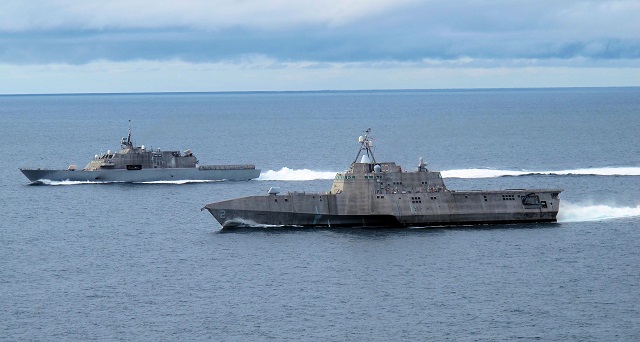 The two classes of Littoral Combat Ship: LCS-1 USS Freedom (background) and LCS-2 USS Independence (foreground). US Navy picture. The two classes of Littoral Combat Ship: LCS-1 USS Freedom (background) and LCS-2 USS Independence (foreground). US Navy picture. |
|||
|
|
|||
|
The US Department of Defense released a Request for Information (RFI) in July this year to let the industry know what the U.S. Navy is expecting from the Fast Frigate, Guided (Experimental) or FFG(X). The RFI says, "A competition for FFG(X) is envisioned to consider existing parent designs for a Small Surface Combatant that can be modified to accommodate the specific capability requirements prescribed by the US Navy."
The U.S. Navy wants a frigate that can keep up with carrier strike groups as well as conduct missions on its own. “The FFG(X) will normally aggregate into strike groups and Large Surface Combatant led surface action groups but also possess the ability to robustly defend itself during conduct of independent operations while connected and contributing to the fleet tactical grid.” The U.S. Navy expects the frigate to be survivable in complex scenarios: "FFG(X) will perform its missions in complex electronic warfare and anti-ship missile threat environments". The new Frigate would likely replace the troubled, very modular, Littoral Combat Ships (LCS) for typical "frigate missions". The U.S. Navy is requesting the FFG(X) to conduct the following missions: - Over the horizon anti-surface warfare (ASuW ) - Anti-submarine warfare (ASW) - Independently escort logistics ship convoys - Electronic warfare (EW) - Electronic signals intelligence and collection (ELINT) The frigate displacement isn't mentionned in the RFI, but it is likely to be comprised between 4000 tons (if the design is to stay as close as possible to the LCS) and in excess of 6000 tons (in view of the requirements set by the U.S. Navy, which is particularly interested on how the shipbuilders can fit VLS for ESSM and Standard Missiles and how many). The U.S. Navy intends to award a Detail Design and Construction contract for the first FFG(X) in 2020. The full RFI can be found at this link. Possible European designs: European shipbuilders that we contacted used broad terms such as "we are looking at the RFI", "we are considering the opportunity", "we are considering the option" or "we are debating it internally". While none of the four companies which talked to us went into specific ship design, here is our own speculation on the likely frigate designs to be proposed, should these companies answer the RFI. |
|
|
|||
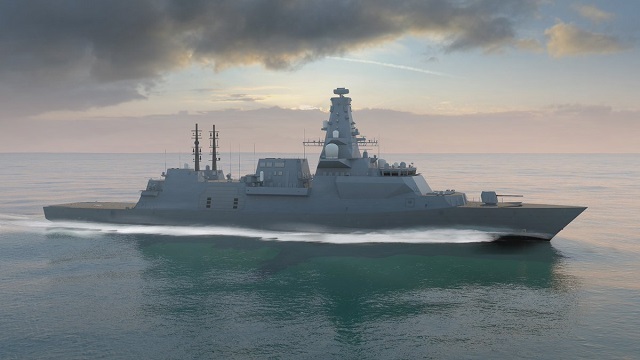 Computer Generated Image of the future Type 26 Global Combat Ship for the Royal Navy. BAE Systems image. Computer Generated Image of the future Type 26 Global Combat Ship for the Royal Navy. BAE Systems image. |
|||
|
|
|||
 Computer Generated Image of the BAE System's Global Combat Ship proposal for the Royal Australian Navy SEA 5000 program. BAE Systems image. Computer Generated Image of the BAE System's Global Combat Ship proposal for the Royal Australian Navy SEA 5000 program. BAE Systems image. |
|||
|
|
|||
|
BAE Systems Type 26 Global Combat Ship
The Type 26 is the future ASW Frigate that will replace the Royal Navy's 13 Type 23 frigates and other ships. BAE Systems says the Type 26 / Global Combat Ship will be a highly capable and versatile multi-mission warship designed to support anti-submarine warfare, air defence and general purpose operations anywhere on the world’s oceans. First steel cut of the first frigate (Glasgow) for the Royal Navy took place in July this year. BAE Systems is also proposing the Type 26 in customized configurations to the Royal Canadian Navy (CSC program) and has been shortlisted for the Royal Australian Navy (SEA 5000 program) with an Australian CEA radar. BAE Systems Global Combat Ship (Royal Navy City-class) specifications: Length: 149.9 meters Max beam: 20.8 meters Displacement: 6,900 tons Accommodation: 118 crew + 72 embarked forces |
|||
|
|
|||
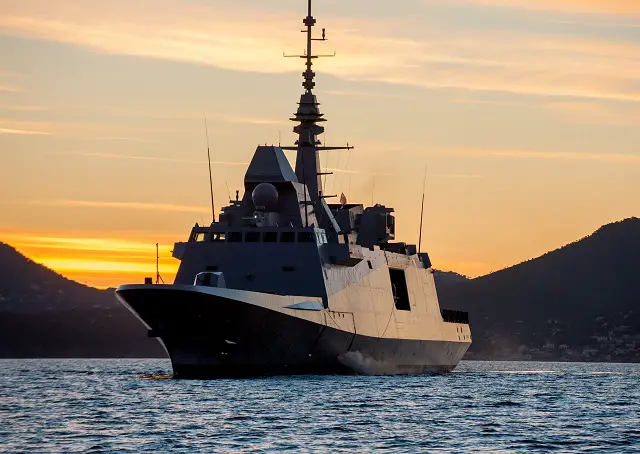 The French Navy FREMM Frigate Provence in Toulon naval base. Picture: Y.Bisson©Marine Nationale The French Navy FREMM Frigate Provence in Toulon naval base. Picture: Y.Bisson©Marine Nationale |
|||
|
|
|||
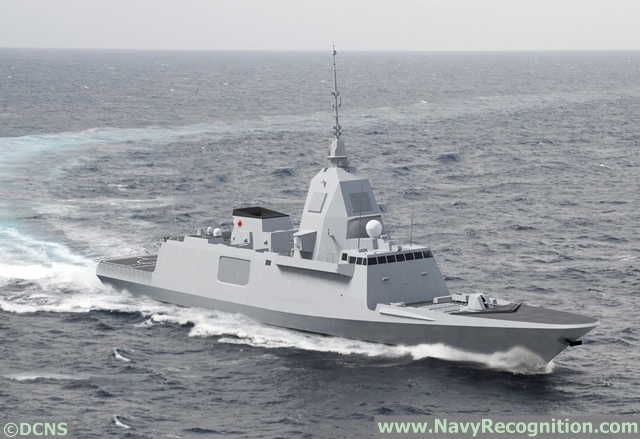 Artist Impression of DCNS proposal to the Royal Canadian Navy CSC requirement (FREMM Frigate in Air Defense variant based on the Aquitaine-class). Picture: Naval Group (DCNS) Artist Impression of DCNS proposal to the Royal Canadian Navy CSC requirement (FREMM Frigate in Air Defense variant based on the Aquitaine-class). Picture: Naval Group (DCNS) |
|||
|
|
|||
|
Naval Group FREMM (Aquitaine-class)
The FREMM ("European multi-purpose frigate"; French: Frégate européenne multi-mission; Italian: Fregata europea multi-missione) is a class of multi-purpose frigates designed by Naval Group (formerly DCNS) and Fincantieri for the navies of France and Italy. In France the class is known as the Aquitaine-class. The FREMM was designed from the start by DCNS as a potent ASW platform with very low acoustic signature even at speed. Naval Group is also proposing the FREMM in a customized configuration to the Royal Canadian Navy (CSC program). Naval Group's FREMM has been exported to the Egyptian and Moroccan Navies. Naval Group FREMM (French Navy Aquitaine-class) specifications: Length: 142 meters Max beam: 20 meters Displacement: 6,000 tons Accommodation: 108 |
|||
|
|
|||
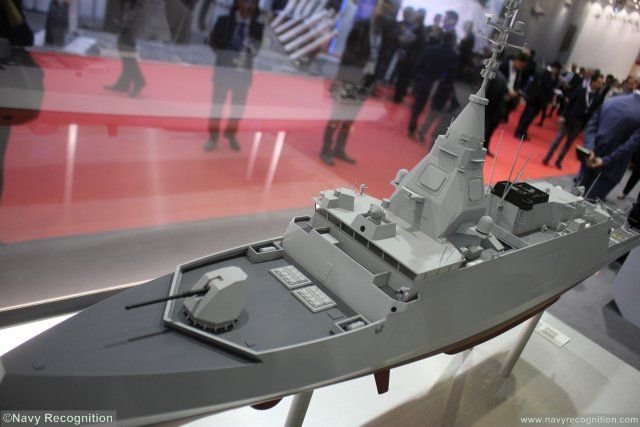 The Belharra unveiled by Naval Group at Euronaval 2016, seen here with a 127mm main gun and RAM launcher. The Belharra unveiled by Naval Group at Euronaval 2016, seen here with a 127mm main gun and RAM launcher. |
|||
|
|
|||
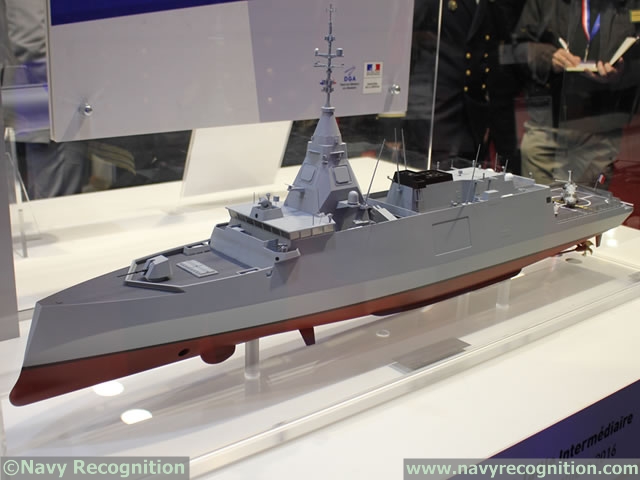 FTI scale model at Euronaval 2016 on the French MoD stand. FTI scale model at Euronaval 2016 on the French MoD stand. |
|||
|
|
|||
|
Naval Group Belharra (FTI-class)
Unveiled at Euronaval 2016, the Belharra is the successor of the La Fayette-class. The French Defence Ministry announced the attribution to DCNS (now Naval Group) of a contract for the development and construction of five FTI (Frégate de Taille Intermédiaire or mid-size frigate) surface combatant intended for the French Navy in April this year. The first of the five frigates should be delivered in 2023 with an entry into active duty in 2025. Naval Group say that Belharra is their answer to navies looking for a compact frigate able to perform a wide range of missions, both stand-alone or within a task force, either for long-range missions on the high seas or shallow-water operations in a congested and contested operational environment. This new frigate features high-level capabilities in anti-air, anti-surface, anti-submarine and asymmetric warfare domains. Naval Group Belharra (French Navy FTI program) specifications: Length: 122.25 meters Max beam: 17.70 meters Displacement: 4,250 tons Accommodation: 125 |
|||
|
|
|||
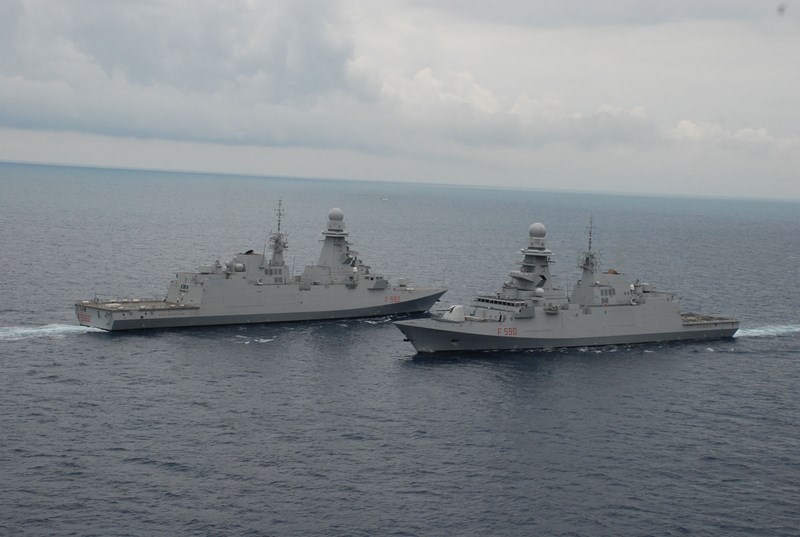 Italian Navy's two variants of the FREMM: ASW FREMM Carlo Margottini (background) and General Purpose FREMM Carlo Bergamini (foreground). Italian Navy picture. Italian Navy's two variants of the FREMM: ASW FREMM Carlo Margottini (background) and General Purpose FREMM Carlo Bergamini (foreground). Italian Navy picture. |
|||
|
|
|||
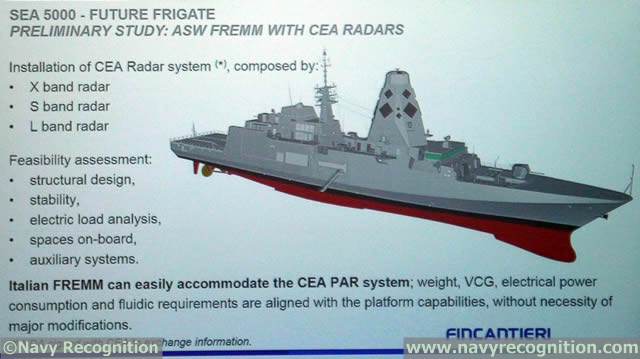 Fincantieri SEA5000 proposal is based on the Italian Navy FREMM ASW design Fincantieri SEA5000 proposal is based on the Italian Navy FREMM ASW design |
|||
|
|
|||
|
Fincantieri FREMM (Bergamini-class & Virginio Fasan-class)
The FREMM ("European multi-purpose frigate"; French: Frégate européenne multi-mission; Italian: Fregata europea multi-missione) is a class of multi-purpose frigates designed by Naval Group (formerly DCNS) and Fincantieri for the navies of France and Italy. The Italian Navy opted for two variants: A general purpose one known as the Bergamini-class and an ASW variant known as the Virginio Fasan-class. A proposal based on the later has been shortlisted for the Royal Australian Navy (SEA 5000 program) with an Australian CEA radar. Fincantieri FREMM baseline specifications: Length: 144 meters Max beam: 19.70 meters Displacement: abt 6,500 tons Accommodation: 145 crew (total 200) |
|||
|
|
|||
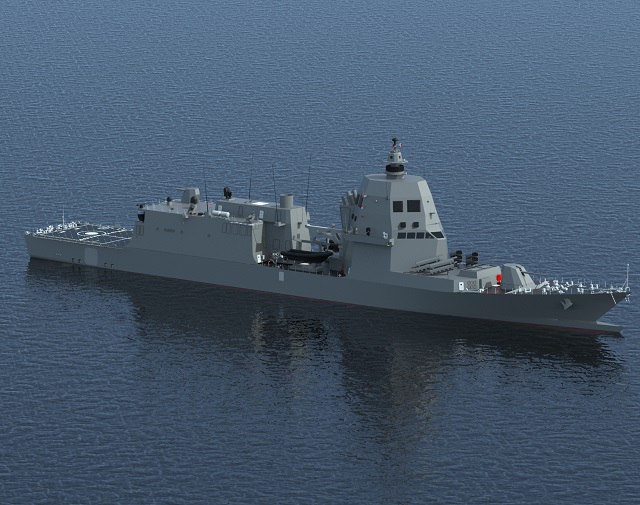 Artist impression of the "PPA Full". Italian Navy picture. Artist impression of the "PPA Full". Italian Navy picture. |
|||
|
|
|||
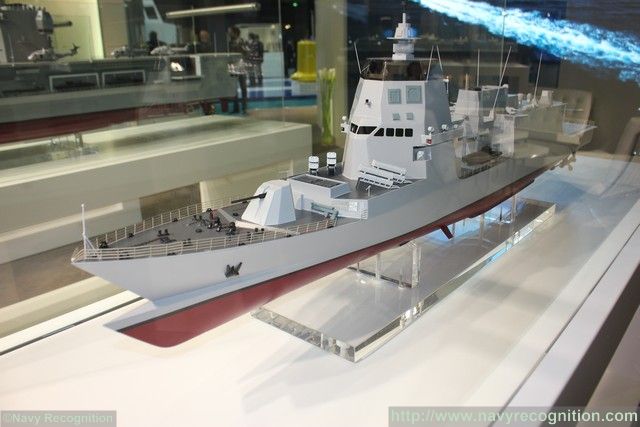 PPA Scale model at Euronaval 2016. PPA Scale model at Euronaval 2016. |
|||
|
|
|||
|
Fincantieri Multipurpose Offshore Patrol Ship (PPA-class)
PPA, Pattugliatore Polivalente d'Altura (Offshore Multipurpose Patrol Ship) is a new Frigate class of the Marina Militare. It is planned to replace eight Minerva class corvettes, four Comandanti class patrol vessels, two Sirio class patrol vessels and four Cassiopea class patrol vessels The PPA, first of seven units, will be delivered in 2021 and it is part of the renewal plan of the operational lines of the Italian Navy vessels, approved by the Government and Parliament and started in May 2015. There will be three variants: PPA Light, PPA Light+ and PPA Full. According to Fincantieri, the multipurpose offshore patrol vessel is a highly flexible ship with the capacity to serve multiple functions, ranging from patrol with sea rescue capacity to Civil Protection operations and, in its most highly equipped version, first line fighting vessel. PPA Full is even set to become an ABM capable vessel. Fincantieri Multipurpose Offshore Patrol Ship (Italian Navy PPA program) baseline specifications: Length: 143 meters Max beam: 16.50 meters Displacement: abt 5,000 tons Accommodation: from 90 (+30) to 171 (+30) |
|||
|
|
|||
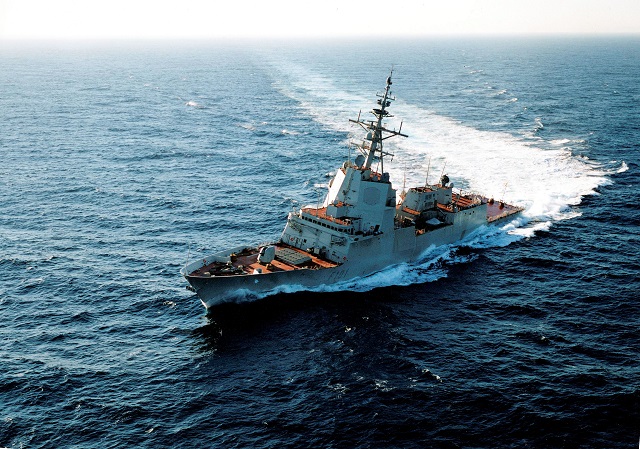 Álvaro de Bazán Frigate of the Spanish Navy. Navantia picture. Álvaro de Bazán Frigate of the Spanish Navy. Navantia picture. |
|||
|
|
|||
 Navantia's SEA5000 proposal is based on the Hobart class Air Warfare Destroyer design. Navantia's SEA5000 proposal is based on the Hobart class Air Warfare Destroyer design. |
|||
|
|
|||
|
Navantia F100 (Álvaro de Bazán-class)
The Álvaro de Bazán-class (also known as the F100 class of frigates) was designed and built by Spanish shipbuilder Navantia for the Spanish Navy. It is fitted with the US Aegis combat system and AN/SPY-1 radar. Norway's Fridtjof Nansen-class and Australia's Hobart-class are both based on the F-100. A proposal based on the Hobart-class has also been shortlisted for the Royal Australian Navy (SEA 5000 program) with an Australian CEA radar. Navantia SEA5000 proposal specifications: Original design: RAN Hobart-class AWD Length overall: 147.2 m Max beam: 18.6 m End of life displacement: 7400 t Accommodation: 237 |
|||
|
|
|||
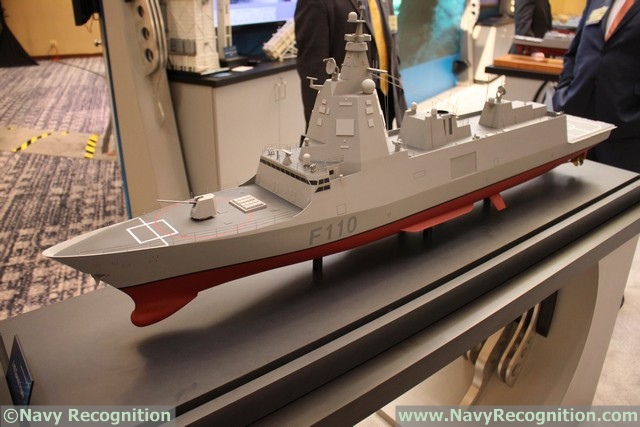 F-110 Frigate scale model on display at SNA 2017 F-110 Frigate scale model on display at SNA 2017 |
|||
|
|
|||
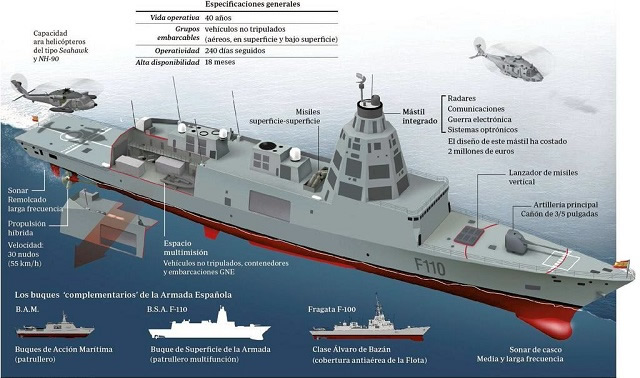 Image source: Spanish Navy/Navantia Image source: Spanish Navy/Navantia |
|||
|
|
|||
|
Navantia F110
The Spanish Navy will be replacing the Santa Maria class FFG Frigate with F-110 Frigates around 2025. The F-110 Frigate is not only focused on substituting the functionality of the "Santa Maria" class but also in providing solutions to facing latest threats and performing future expected missions. From the start of the program, Navantia has been cooperating closely with the Spanish Navy in the requirements for a 21st century frigate and in 2015 Navantia signed a contract with the Spanish MoD for the development of the project definition phase. In parallel, a suite of technological R&D programs have been initiated looking to acquire the latest innovations to be incorporated in the F-110 program. There are 5 units of the class planned with launch of the first unit expected for 2021. Navantia F110 specifications: Length overall: 145 meters Max beam: 18 meters Displacement: 6,100 t Accommodation: 150 |
|||










